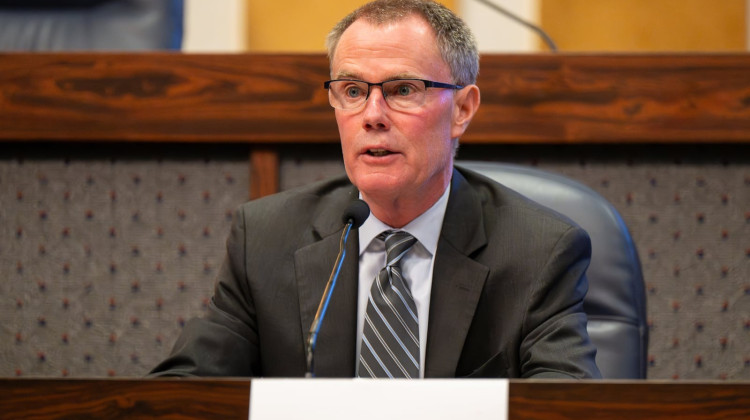
While four in 10 Indiana students are eligible for 21st Century Scholars, only half of them apply.
MD Duran/UnplashHelen Rummel, Chalkbeat Indiana
Katie Keegan will always be grateful to her mom for pushing her to apply to 21st Century Scholars, a needs-based scholarship and mentoring program. Without it, she says, she might not be studying at Purdue University right now.
Her graduating class, the class of 2020, saw Indiana’s steepest decline in college-going rates in recent memory. That year, only 53% of graduating Indiana high schoolers went straight to college, a steep drop from 58% the previous year. But Keegan said she was able to attend Purdue thanks to the support and mentorship from Indiana’s 21st Century Scholars Program, a state financial aid program that helps many Indiana students from low-income families who qualify.
During high school, Keegan met with advisors through the program who guided her through applications like the federal student aid form known as the FAFSA, and answered her questions about college. And the program ultimately provided her with a scholarship allowing her to reach higher education.
“When you know that you’re going to be okay because you don’t have to worry about ‘How am I going to pay this off?’ everything else just kind of feels better,” she said.
Keegan’s story with the program is a successful one, but there’s evidence that not enough students get a chance to emulate it. While 80% of Keegan’s fellow 21st Century Scholars went on to college in 2020, just over half of the overall graduating class did. Yet while four in 10 Indiana students are eligible for 21st Century Scholars, only half of them apply. Such numbers leave some advocates and others wanting better access to programs designed to help students bridge the gap between K-12 and college.
Meanwhile, over the last decade, the share of Indiana’s low-income students going to college — the same population served by the program that helped Keegan — has plunged by 26 percentage points. There have also been declines of 20 percentage points among Black students and 7 percentage points among Hispanic students, all over the last decade.
Rachel Santos, director of education policy at the Indiana Latino Institute, said there are a number of hurdles students and families must cross when planning for college. Automatically enrolling students in programs like 21st Century Scholars would ensure that they are made aware of options and resources that can help them, she said.
“We know that this program can help students get into college and not have the burden of debt,” Santos said. “Students who are in the program, they’re much more likely to enroll in college and then once they’re in college, they get more support and they’re likely to succeed.”
The program isn’t a guarantee of success. In 2020, 37% of the 21st Century Scholars graduated from college on time. This lags behind the 44% state average for on-time graduation, but it is considerably higher than the rate for other low-income students of 27%. And the share of students in the program graduating on time has improved in recent years.
The higher education landscape itself, along with the workforce opportunities available to students after high school, has changed in recent years in ways that may be beyond the direct control of schools, students, and officials. But Chris Lowery, the commissioner for Indiana’s Commission for Higher Education, said those who attribute declines in college-going rates solely to the pandemic are mistaken.
“There are clear economic benefits that come with greater levels of education,” Lowery said in a May release. “People with a bachelor’s degree or higher are more likely to be employed and participating in the workforce, and they have significantly higher wages and a greater overall net worth.”
Like Santos, he’s called for auto-enrolling students in 21st Century Scholars.
Eligibility for the program, founded in 1990, is based on a student’s household income, alongside their residency status. But when students start to apply in the 7th and 8th grades, they have to explain why they want to pursue higher education. Once students reach the 9th grade it’s too late for them to apply as the rules currently stand.
That happened to align well with the approach taken by Keegan, who had been planning for college since she was in middle school.
“It’s something that not a lot of people do, or not a lot of people have to think of,” Keegan said. “But I had to sit down and think of why I’m fit to go to college and why that’ll benefit my mom and I at such a young age.”
Keegan described being accepted into 21st Century Scholars as creating a domino effect, in a good way. A huge weight had been lifted off her shoulders, and everything else seemed a bit more possible.
Once she began to participate in the program, she started to envision herself at college. And when she knew she wouldn’t have to take on debt to support herself, she became focused on the application process. Students in the program like Keegan receive up to 100% of tuition at public two- and four-year colleges in Indiana, along with certain fees, and the program also pays for some tuition costs at private, independent, and approved for-profit schools. Students in the program pledge to graduate high school with a cumulative GPA of at least 2.5.
She also said being in the program made her work harder in high school in Connersville, a small Indiana town where the median household income is nearly $30,000 less than the national average of $67,520 in 2020.
Even now as a Purdue student, Keegan sets boundaries for herself in college to maintain good standing with the scholarship program — that means maintaining a strong GPA and full-time class schedule. Students also promise to complete at least 30 credit hours each year to stay on track toward earning a degree on time.
Santos believes 21st Century Scholars’ emphasis on mentoring and personalized support is what has proven to be truly successful with the students she has worked with in the past. Not everyone, she said, can have parents who have the time or knowledge to help them through the process of preparing for college.
“I don’t think just giving students money is the solution to having them succeed,” Santos said. “In higher ed, I think you need cohort style programs. You need community programs.”
While the Commission for Higher Education administers the scholarships, state lawmakers, among others, will also need to be on board with the change. Right now, the commission is putting together analyses on the return of investment for the program in hopes of advocating for auto-enrollment.
More than 45,000 students in the state have obtained their degrees with the help from the scholarship. The commission hopes to increase this number considerably, but they understand it will cost more to do so. In Lowery’s opinion, it’s more than worth it.
“What an incredibly good return on investment it is,” Lowery said. “We statistically know that with increased educational attainment, on average, we spend a lot less on an individual and his or her loved ones in social spending.”
Lowery says the program is old enough that they have already seen the generational impacts. Some students who graduated through the program now have their own children, who are also now more likely to obtain a college degree.
While the share of Indiana students going straight from high school to college has declined recently, that doesn’t mean other students will never go on to higher education.
Chris Foley, director of online education for Indiana University, said online enrollment for them has increased since 2016. Most of the uptick consists of adults who work to get their degree some time after graduating high school, but recently, he said, more students have enrolled in online education immediately following high school. Since many recent students experienced virtual learning due to the pandemic, Foley anticipates online higher education to fill a role for many in the future.
In addition to the flexibility students have when pursuing higher education, Foley said there are other job opportunities that didn’t exist before as well.
“There’s a wide variety of things that I think students have at their fingertips now that I know I didn’t when I went to college 30 years ago,” Foley said.
But others, like Lowery, have concerns about the long-term effects on some who might enter the workforce too soon.
“If individuals go directly into the workforce, if it’s right for them and they can continue to progress to their satisfaction, that’s super,” Lowery said. “But I do have concern if they will continue to have the skills over their working lifetime to progress.”
When Keegan arrived at Purdue, she explained 21st Century Scholars to a girl she met living on the same floor. The girl was surprised to learn that Keegan had been thinking about and planning for college for years, whereas she knew her parents would fund her college career.
“After we (had) that conversation it was a real eye opener for both of us,” Keegan said. “Because we’re both coming from such different socioeconomic statuses. You don’t really tend to think about how we all ended up with the same place, same floor, same dorm. When I think about that, that’s two very different stories.”
Keegan recommends all students look into local scholarship opportunities, including 21st Century Scholars and other programs such as the Frank O’Bannon Grant and Lilly Endowment Community Scholarship.
She said some of her peers write college off as “just more school” when considering a plan after high school, when in fact her positive experiences range far beyond the coursework and even the people she’s met on campus. Keegan just returned from a study abroad program in Scotland — something she says she wouldn’t have been able to do without financial aid.
“I think a lot of people look at it as more school: ‘I gotta go sit and learn more,’” Keegan said. “When in reality, there’s so much more to it.”
Keegan hopes the state can bring college enrollment numbers back up in the coming years. To her, it would mean more students can look back toward their high school years with gratitude, like she is able to.
Chalkbeat Indiana partners with Open Campus on higher education coverage.
Helen Rummel was a summer reporting intern covering education in the Indianapolis area.
Chalkbeat is a nonprofit news site covering educational change in public schools.
 DONATE
DONATE








 Support WFYI. We can't do it without you.
Support WFYI. We can't do it without you.